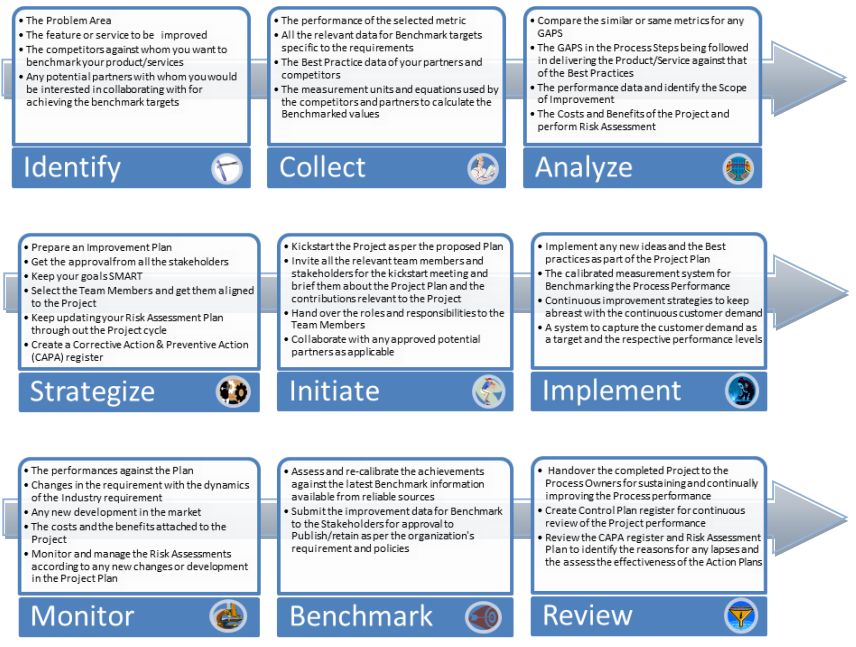How does one feel if they are adjudged the best?
Top of the world!
They become famous and recognized and appreciated by one and all, wouldn’t they?
Yes, we are going to discuss Benchmarking here which is nothing but a bar/target showcasing who is the best in the Industry. We maybe wondering why does an organization stress so much on achieving or surpassing an Industry Benchmark. It is but quite obvious that achieving a Benchmark Standard or surpassing it would improve and/or even increase their customer base and loyalty which is directly proportional to their business performance.
Benchmarking Approach
We need to know more about Benchmarking and its benefits to achieve the business requirements, so let’s discuss it in detail. When we talk about Benchmark, we should check on few points that are enlisted below so that it is easier to work towards achieving/surpassing it.
- Benchmarking should be done against similar or same Industries – an apple should be compared with an apple and not an orange.
- Benchmarking should be done for specific metrics that are crucial for a product or an organization’s performance. For e.g., Quality, Cost, Productivity (Time – Takt/Cycle/Lead Time), etc.
- Identify the GAPS in the process that will help in identifying the current state and create plans by comparing stage-wise performance to achieve the required goal.
- Get all crucial Best Practices followed by an organization which has set the Benchmark. This is really crucial as this will help in comparing and strategizing on improving their performances from the existing set Benchmark targets. Therefore, Process Benchmarking is also referred to as Best Practice Benchmarking.
- Always apply SMART (Specific, Measurable, Attainable/Achievable, Relevant & Time Bound) rules when setting goals and work out the financials or in other words do Cost Benefit Analysis to identify if the benefits reaped are higher than the cost that would be incurred in trying to implement a new set-up. Time is an important aspect here any delayed action can result in the competitors having an edge over the products and services.
- Identify any potential partners who can collaboratively work towards achieving the Benchmark Standards.
Types of Benchmarking
There are many books that have been published about Benchmarking and their practices. These books give different approaches available to work towards Benchmarking a process. Once you know what needs to be achieved and if it is doable, an organization should strategize on achieving these through various Process Improvement exercises, right from PDCA, Kaizen (that brings small continuous improvements) to Six Sigma Projects, etc. There are various types of Benchmarking some of which worth discussing are below.
Product Benchmarking: This is done for a new Product or an upgraded Product. For e.g., battery life of a Smartphone is something which a customer would appreciate. With almost all the Smartphones having similar features nowadays, any company that taps on a product feature that a customer is interested and sensitive about will boost their business performances. Hence setting or achieving a Benchmark target for the feature in demand will make a huge difference.
Process Benchmarking: This is applied for a Process that can act as a Centre of Excellence and help an organization to expand their business by bagging similar Processes or outsource their Benchmarked process to achieve operating cost benefits.
Functional Benchmarking: Functional Benchmarking is generally done to identify and achieve efficiency across different function. This is done by disintegrating the Project based on their Functions (like HR, IT, Operations, Administration, etc.) and then working separately on improving each function so that the improvement strategies can be applied for similar Functions across the organization.
Performance Benchmarking: This Benchmark is very crucial for all Industries and is the main criteria in Product Benchmarking. Performance Benchmarking helps in keeping a competitive edge in an Industry as high performance directly impacts the business performance of an organization. Customers would be more inclined towards a company with better performances and this trust stimulates better business.
Financial Benchmarking: As the name indicates, this is done to improve the financials of an Organization. This actually embraces the other types of Benchmarking as each Benchmarking strategy work towards either reducing the cost of the company, or improving the efficiency, or at increasing the sales or revenue of an Organization.
It is very clear why an Organization should work on Benchmarking or achieving any set Benchmarks in the Industry. There are tools and databases available with many Organizations that are involved in defining Standards or that conduct Surveys and Polls to publish books about the performance of different Organizations. With vast information available from different sources, one must be completely sure about the source of information before starting to work on the Benchmarking exercise.
To be in the race, one must study the strength and weakness of their opponents and thereafter improve their potential before the game begins to win the race. Benchmarking is similar to a race, so to win the race – strategically plan and work towards winning the Trophy!

